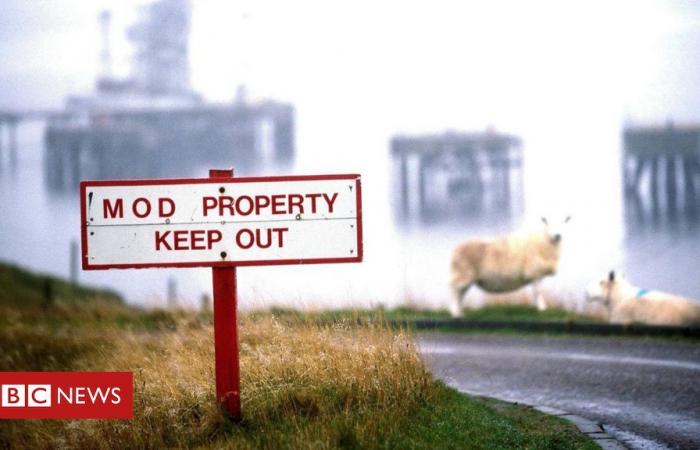- author, Myles Burke
- Roll, BBC Culture
-
17 minutes ago
“This place they call the island of death, the island of mystery, and for good reason,” said BBC reporter Fyfe Robertson in 1962. Buffeted by the wind, he spoke from across the bay, opposite the remote and desolate Scottish island of Gruinard.
“But this is not a story of ancient dark deeds, nor a superstition of the Scottish Highlands,” the reporter continues. “No, this story began in 1942.”
“The war had already been going on for three years when a group of scientists from the War Office suddenly took possession of the island and began carrying out experiments so secret that, even today, 20 years later, very few people know what happened there. And the local inhabitants They weren’t told anything.”
Robertson intended to investigate stories of dangerous government experiments believed to have been carried out at Gruinard.
At the time of his reporting, the UK Ministry of Defense had already banned access to Gruinard and Robertson was unable to convince fearful locals to take him by boat around the island for a closer look.
What happened was an environmental catastrophe. Tragically, the island remained a dangerous, contaminated and closed area for around half a century. It was only on April 24, 1990, that the British government finally declared the island safe.
Gruinard was the site of a clandestine attempt by the United Kingdom during the Second World War to use anthrax – a deadly bacterial infection – as a weapon of war.
The precise details about what happened there only became public in 1997. That year, the government released a film made at the time by the military, detailing the experiments.
The project was called Operation Vegetarian. It began under the command of Paul Fildes (1882-1971), then head of the Department of Biology at Porton Down, a military installation in Wiltshire, England, that still exists today.
Porton Down was established in 1916 as the War Department Experimental Station. Its objective was to study the effects of chemical weapons agents, which were increasingly used as the First World War progressed.
In the 1940s, the United Kingdom was once again at war and Porton Down was tasked with developing biological weapons that could be used against Nazi Germany with catastrophic effects, minimizing direct combat between troops.
The plan was to infect flaxseed cakes with anthrax spores and drop them by plane over cattle pastures across Germany. The cows would eat the cakes, contract anthrax, and transmit it to people who ate the infected meat.
Anthrax is a naturally occurring, deadly organism, and symptoms of the infection may take time to fully appear. But when they appear, they are horrible symptoms and can be lethal very quickly.
If put into practice, the plan would have decimated Germany’s meat supply and caused anthrax contamination throughout the country, resulting in a huge number of deaths.
But to begin to understand how anthrax would work as a weapon in a real-world environment, researchers needed an outdoor location, away from populated areas, to run tests.
Therefore, in the summer of 1942, the military purchased the remote uninhabited island of Gruinard, measuring just over 2 km², and prohibited the region’s inhabitants from entering the site.
A military team supervised by scientists began carrying out frightening experiments. Using animals brought to the island as test subjects, they began a series of tests releasing anthrax spores across the island’s terrain.
“The aim was to test whether anthrax would survive an explosion in the field, which they didn’t know, and whether it would remain virulent,” said Edward Spiers, professor emeritus at the University of Leeds, in the United Kingdom, in the BBC Scotland documentary The Mystery of Anthrax Island (“The Mystery of Anthrax Island”, in free translation), 2022.
“About 80 sheep were tethered at various stages downwind of the impending explosion,” he says. “The explosion was detonated by remote control. It was not large, but a highly powerful stream of spores moved in the wind, causing infection and death wherever it went.”
The results were devastating. Days after exposure, the sheep began showing symptoms and quickly died. Their infected bodies were autopsied and incinerated or buried under tons of rubble.
Some of these experiments were witnessed by local small farmers who identified clouds of anthrax floating over the island.
A local resident, who had sold sheep to the team of scientists, recalled seeing what he described as smoke descending on the animals.
“I think it was all kinds of poisonous gas, anthrax,” he told Robertson in 1962.
The secret tests continued until 1943 and the military considered their results a success. The scientists then returned to Porton Down.
As a result, five million anthrax-infected flaxseed cakes were produced, but the plan was eventually abandoned with the successful invasion of Normandy, France, by the Allies. The cakes were destroyed after the war.
By 1952, the United Kingdom had already developed another weapon of mass destruction, as it realized its ambition to become the world’s third nuclear power.
Four years later, the country ended its offensive biological and chemical weapons program. And, in 1975, the United Kingdom ratified the Biological Weapons Convention, which prohibits all use, production and storage of this type of weapon.
‘Operation Vegetarian’
The consequences of Operation Vegetarian were catastrophic for the island.
Anthrax is a very resistant bacteria that can persist for decades in soil, causing infections when ingested, even years after an outbreak.
Military experiments have left the island too dangerous for people or animals to live on it. The rainwater running off the island itself could be lethal.
In the months following the tests, animals on land near Gruinard Bay began to die.
In her study entitled Contamination and Compensation, author Elizabeth Willis mentions that the British government secretly paid compensation to those affected, but declared that the deaths were caused by a sick sheep that had fallen from a Greek ship that was passing through.
A local resident told the BBC in 1962 that “it was quite obvious to us that they knew something about it or they wouldn’t have made the payments so quickly.”
The military placed the island under indefinite quarantine and installed signs warning visitors to stay away.
In the decades that followed after the Second World War, attempts were made to decontaminate the site, using chemical treatments and controlled burning. But these initiatives have largely proven ineffective.
In 1971, a series of tests demonstrated that although there were no longer any anthrax spores on the surface, they still remained underground, posing a serious risk to anyone entering the island.
An environmental group called the Dark Harvest Commandos landed on the island in 1981 and collected samples of anthrax-infected soil.
They left a bucket of that soil in front of Porton Down, to warn of the island’s deadly contamination. His objective was to force the government to take some action in this regard.
Five years later, scientists tried again to decontaminate the site, dousing the island with a mixture of seawater and formaldehyde. They also removed and incinerated the contaminated top layer of soil.
This time, they were more successful and finally, on April 24, 1990, after 48 years of quarantine, the British government declared the island of Gruinard free of anthrax.
Gruinard was not the only place where the UK carried out secret biological weapons testing. But it was the first.
The consequences of what happened there remain a grim reminder of the risks of biological warfare and the human capacity for destruction.
Tags: mysterious British island death scene secret experiments World War
--





